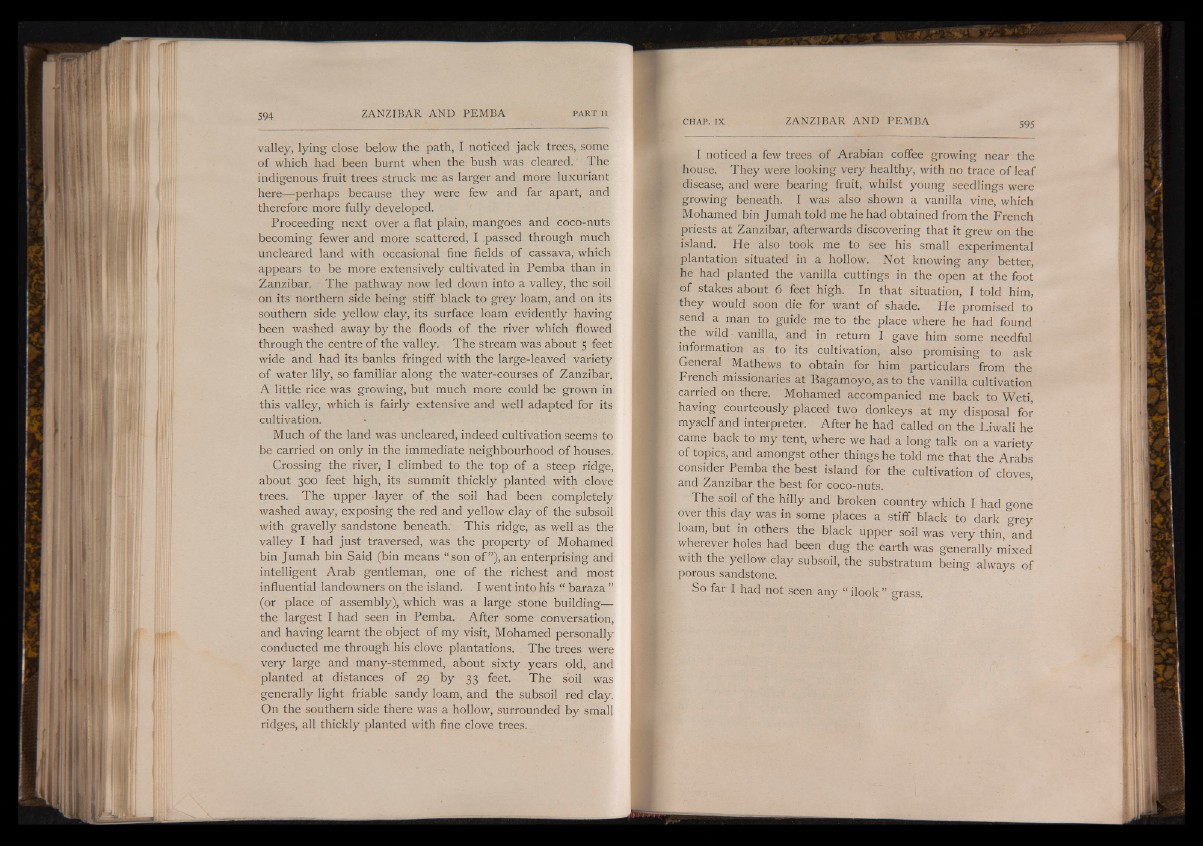
valley, lying close below the path, I noticed jack trees, some
of which had been burnt when the bush was cleared.' The
indigenous fruit trees struck me as larger and more luxuriant
here— perhaps because they were few and far apart, and
therefore more fully developed.
Proceeding next over a flat plain, mangoes and coco-nuts
becoming fewer and more scattered, I passed through much
uncleared land with occasional fine fields of cassava, which
appears to be more extensively cultivated in Pemba than in
Zanzibar. The pathway now led down into a valley, the soil
on its northern side being stiff black to grey loam, and on its
southern side yellow clay, its surface loam evidently having
been washed away by the floods of the river which flowed
through the centre of the valley. The stream was about 5 feet
wide and had its banks fringed with the large-leaved variety
of water lily,, so familiar along the water-courses of Zanzibar.
A little rice was growing, but much more could be grown in
this valley, which is fairly extensive and well adapted for its
cultivation.
Much of the land was uncleared, indeed cultivation seems to
be carried on only in the immediate neighbourhood of houses.
Crossing the river, I climbed to the top of a steep ridge,
about 300 feet high, its summit thickly planted with clove
trees. The upper layer of the soil had been completely
washed away, exposing the red and yellow clay of the subsoil
with gravelly sandstone beneath. This ridge, as well as the
valley I had just traversed, was the property of Mohamed
bin Jumah bin Said (bin means “ son o f ”), an enterprising and
intelligent Arab gentleman, one of the richest and most
influential landowners on the island. I went into his “ baraza ”
(or place of assembly), which was a large stone building—
the largest I had seen in Pemba. After some conversation,
and having learnt the object of my visit, Mohamed personally
conducted me through his clove plantations. The trees were
very large and many-stemmed, about sixty years old, and
planted at distances of 29 by 33 feet. The soil was
generally light friable sandy loam, and the subsoil red clay.
On the southern side there was a hollow, surrounded by small
ridges, all thickly planted with fine clove trees.
I noticed a few trees of Arabian coffee growing near the
house. They were looking very healthy, with no trace of leaf
disease, and were bearing fruit, whilst young seedlings were
growing beneath. I was also shown a vanilla vine, which
Mohamed bin Jumah told me he had obtained from the French
priests at Zanzibar, afterwards discovering that it grew on the
island. He also took me to see his small experimental
plantation situated in a hollow. Not knowing arty better
he had planted the vanilla cuttings in the open at the foot
of stakes about 6 feet high. In that situation, I told him,
they would soon die for want of shade. He promised to
send a man to guide me to the place where he had found
the wild vanilla, and in return I gave him some needful
information as to its cultivation, also promising to ask
General Mathews to obtain for him particulars from the
French missionaries at Bagamoyo, as to the vanilla cultivation
carried on there. Mohamed accompanied me back to Weti,
having courteously placed two donkeys at my disposal for
myself and interpreter. After'he had called on the Liwali he
came back to my tent, where we had a long talk on a variety
of topics, and amongst other things he told me that the Arabs
consider Pemba the best island for the cultivation of cloves,
and Zanzibar the best for coco-nuts.
The soil of the hilly and broken country which I had gone
over this day was in some places a stiff black to dark grey
loam, but in others the black upper soil was very thin, and
wherever holes had been dug the earth was generally mixed
with the yellow clay subsoil, the substratum being always of
porous sandstone.
So far I had not seen any “ ilook ” grass.